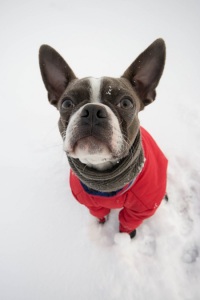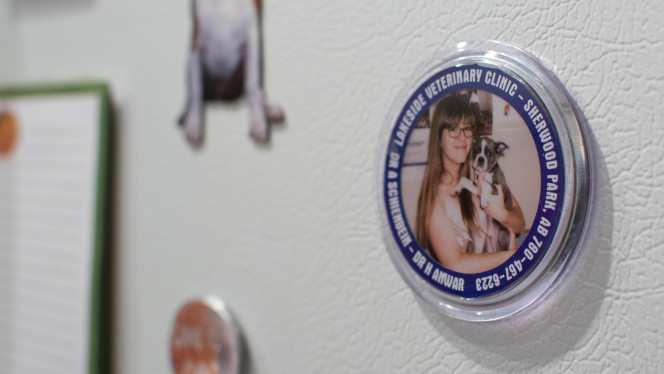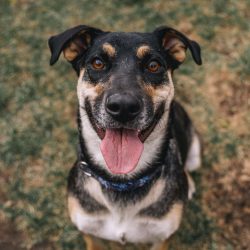Lakeside Veterinary Clinic, in Sherwood Park, AB, is one of our partner vets, who helps us out in a big way by providing quality care to our rescues at reduced rates. Lakeside treats cats, dogs, and the occasional rabbit, and has been running for 15 years under the current owner. Dr. Anwar, who has been with Lakeside for 9 years, and Darlene, an Animal Health Technician, graciously agreed to a Q &A session, covering some handy health tips for owners, as well as some seasonal advice for winter and the holidays.
What is the most common preventable accident that pets come in for?

Dr. Anwar, our friendly Q&A vet.
Without hesitation, Dr. Anwar fired them off. “Parvovirus and foreign bodies. And for outdoor cats, bites.”
Of course, I had to ask.
And what is the most common foreign body?
“Socks.” Yep, they seem pretty harmless (which is probably why they’re eaten so often!), but if a dog can’t pass it, a trip to the vet is in order. Other commonly ingested objects included toys and wedding rings.
Are there some symptoms that owners fail to act on?
Dr. Anwar and Darlene provided a short list:
• Foreign bodies (you should only wait 24 hours before visiting the vet.)
• Constipation in cats. In some cases, what seems like a simple case of constipation is actually a urinary blockage, which can be quite serious.
• Problems with the eyes. Owners tend to wait for them to get better, but if it worsens, there are fewer options for treatment.
And on a more general note, cats are very good at hiding their illnesses, and so often go untreated for longer.
Both Dr. Anwar and Darlene noted that people rarely call in to just ask. But they should. Phone calls are free, and the answer will not always be ‘bring them in and we’ll see.’ I called Lakeside when my dog swallowed a neighbor’s cat toy, and they advised that I a) remain calm, and b) wait 24 hours and monitor his poop before bringing him in. So next time something happens and you’re wondering what to do, just call.
 Okay, now let’s talk winter. What do you suggest for preparing dogs for the cold temperatures?
Okay, now let’s talk winter. What do you suggest for preparing dogs for the cold temperatures?
“Go to Mexico.” But seriously, small, young, and short-haired dogs are prone to hypothermia, so they should have garments that keep them warm. Larger, furry dogs are usually okay, but long-haired dogs should wear boots to keep ice from building up between their toes. And depending on activity, some dogs may need more calories to compensate for the energetic costs of keeping warm. (Good news for those food-driven pups!)
So how cold is ‘too cold’?
“Below -20 degrees Celsius. Below this temperature, dogs should only go on very short walks. And don’t forget to take into account the wind chill factor.”
Some dogs get dry and cracked skin on their toes and nose in the winter. What can owners do to prevent or treat this?
The solutions are similar to those who suffer from dry winter skin: you can get a humidifier, and start moisturizing. There are a variety of dog-specific moisturizers and balms available. But Darlene suggested plain ol’ Vaseline.
Over the holidays, it’s especially hard not to over-feed pets. What are some of the risks of over-feeding?
 Dr. Anwar and Darlene suddenly became very animated: the holidays are evidently a busy time for them. Along with the more familiar warnings against giving pets chocolate (it’s poisonous to them), and keeping tinsel and ribbon out of reach, Dr. Anwar had a surprising statistic: during the holiday season, Lakeside treats 2-3 dogs per week for pancreatitis, which is caused by eating fatty foods like turkey drippings. Pancreatitis, or inflammation of the pancreas, can cause vomiting, diarrhea, fever, and in severe cases, death. Dr. Anwar recommended against sharing high-fat human foods, and suggested keeping an eye on the kids, who are the ones most likely to share holiday goodies.
Dr. Anwar and Darlene suddenly became very animated: the holidays are evidently a busy time for them. Along with the more familiar warnings against giving pets chocolate (it’s poisonous to them), and keeping tinsel and ribbon out of reach, Dr. Anwar had a surprising statistic: during the holiday season, Lakeside treats 2-3 dogs per week for pancreatitis, which is caused by eating fatty foods like turkey drippings. Pancreatitis, or inflammation of the pancreas, can cause vomiting, diarrhea, fever, and in severe cases, death. Dr. Anwar recommended against sharing high-fat human foods, and suggested keeping an eye on the kids, who are the ones most likely to share holiday goodies.
If you’ve been looking for a vet, consider Lakeside. The vets, AHTs, and staff are all friendly and knowledgeable. There are also a few resident cats (Tiger, Herbie, and George), who function as a welcoming committee. And you can’t beat the complimentary fridge magnets.






